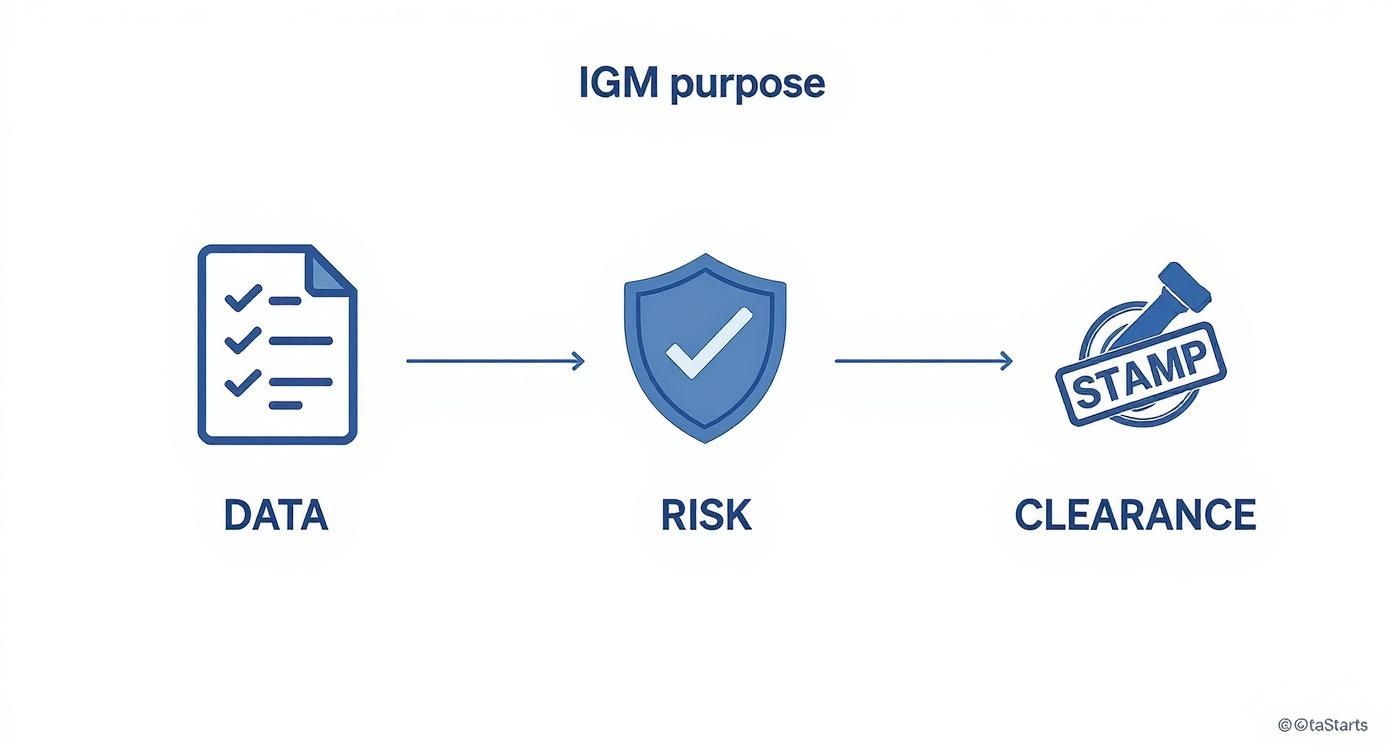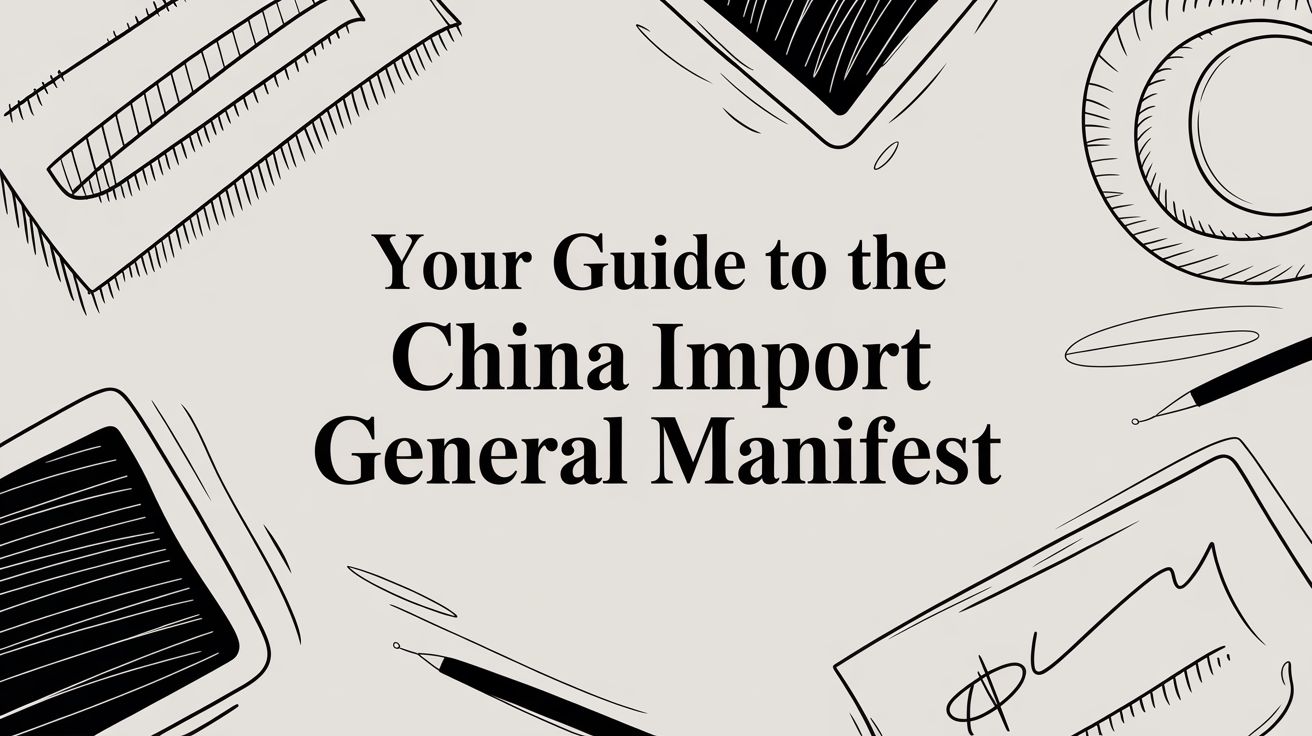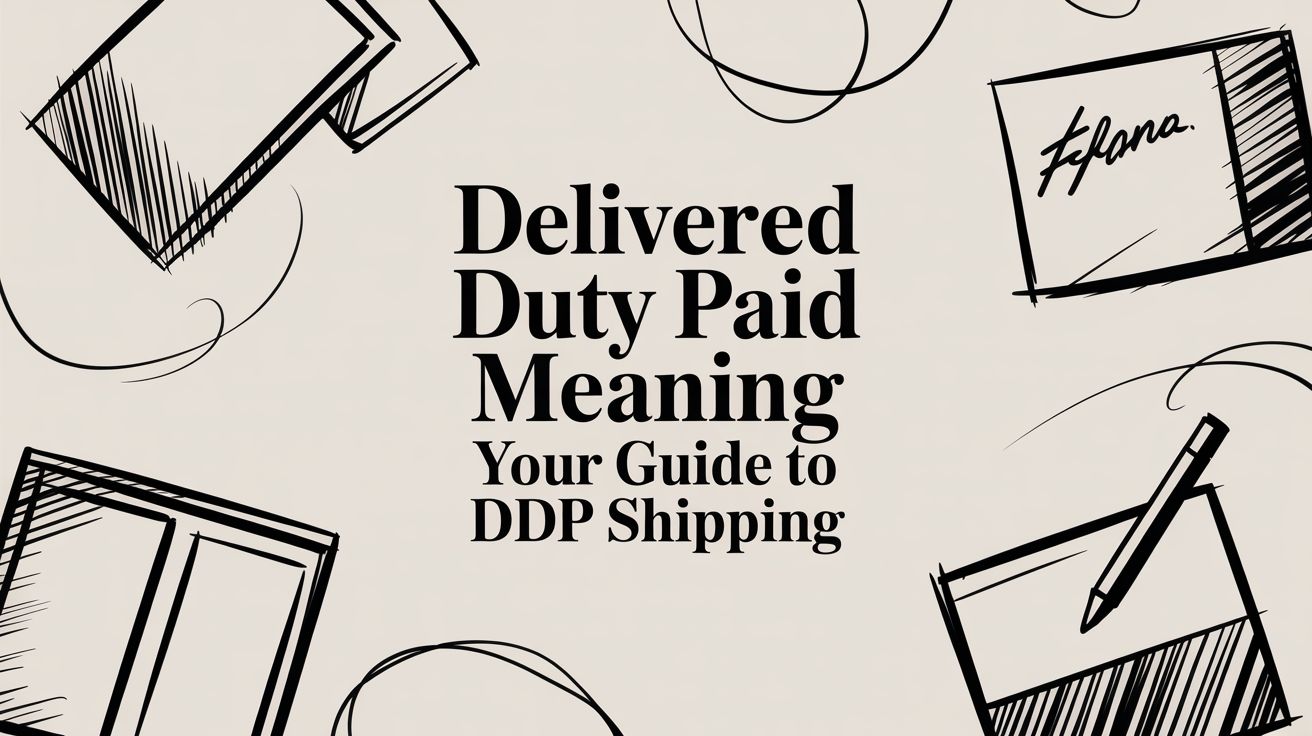Think of the Import General Manifest (IGM) as the official guest list for every piece of cargo arriving in China. Before a ship docks or a plane lands, the carrier has to submit this master document to Chinese Customs, detailing every single shipment on board. It’s the very first handshake between your cargo and the authorities, setting the stage for the entire import process.
The Role of the Import General Manifest in Chinese Customs
Let's use a simple analogy. Picture an international airport. The airline has to give border control a full list of all passengers long before the plane touches down. The IGM does the exact same thing, but for goods. It gives customs officials a complete, high-level view of everything that's about to enter the country.
This isn't just bureaucratic box-ticking. This pre-arrival declaration is a vital tool for managing national security and the economy. It allows authorities to get a head start on screening cargo, flagging potential risks, and pre-clearing legitimate shipments to keep things moving. Without this system, Chinese ports would quickly become gridlocked, causing massive delays and chaos.
The Foundation of Customs Clearance
The IGM is essentially the single source of truth for all cargo on a vessel or aircraft. It serves a few crucial purposes:
- Risk Assessment: Customs officials scan the manifest data to pinpoint high-risk shipments that might need a closer look. This helps them identify potential security threats or illegal goods before they even arrive.
- Duty and Tax Calculation: The information on the IGM provides the initial data needed to start calculating duties and taxes, which speeds up the financial side of clearance once the cargo is on the ground.
- Resource Planning: Port authorities use the manifest to plan everything from where to unload a vessel to how much warehouse space is needed and what inland transport will be required.
Why Accuracy Is Non-Negotiable
Every single detail on the IGM counts. A small mistake or a vague description can throw up an immediate red flag, landing your shipment in the queue for a full, time-consuming physical inspection. China's customs systems are sophisticated; they track and analyse this data constantly to monitor trade flows and enforce regulations. In fact, all of China's import activities are tracked via the IGM, which is then used to generate detailed statistics on trade by commodity and country.
The IGM is more than just paperwork. It's the official introduction of your goods to Chinese authorities. A clean, accurate, and timely manifest paves the way for a smooth journey through customs. Errors, on the other hand, almost always lead to costly delays and penalties.
At the end of the day, getting to grips with key documents and terms like the IGM is essential for anyone in the import game. For a deeper dive into the language of logistics, our freight forwarding terminology glossary is a great place to start. This kind of foundational knowledge ensures you and your carrier are on the same page, aiming for the same goal: a successful, hassle-free import.
Who Files the IGM and When
So, who's actually responsible for getting the Import General Manifest (IGM) filed? This is a crucial piece of the puzzle for any smooth import into China. The bottom line is that the legal duty falls squarely on the carrier—the company physically moving the goods.
Think of it this way: the carrier is the captain of the ship (sometimes literally!). They have the complete picture of every single piece of cargo on board, not just yours. Because of this, they are the only ones who can provide a full, consolidated manifest to customs. This responsibility can't be passed off to the importer or the exporter.
The Key Parties Responsible
While you, the importer, supply the details for your specific shipment, the carrier is the one who bundles all that information together. The main players responsible for submitting the IGM are:
- Shipping Lines: For any cargo arriving by sea, the container line or vessel operator handles the IGM filing.
- Airlines: When goods are flown in, the airline is legally on the hook for submitting the manifest.
- Rail Operators: If your shipment is coming in by train, the rail company is in charge of the paperwork.
Your freight forwarder is your essential partner in this process. They act as the coordinator, making sure your documents are spot-on and get to the carrier on time. But remember, the ultimate legal responsibility rests with the carrier.
The Critical Importance of Filing Deadlines
When it comes to the IGM, timing isn't just important—it's everything. China Customs has very strict pre-arrival deadlines. These aren't suggestions; they're firm rules designed to give officials enough time to check for any risks before the cargo even gets close.
A late IGM is an instant red flag for customs. It can trigger hefty fines, force a mandatory inspection of your goods, and leave your shipment stuck at the port, throwing your entire supply chain into disarray.
The most famous of these deadlines is for sea freight, widely known as the "24-Hour Rule." This isn't a guideline; it's a mandate. The carrier must submit the IGM to China Customs at least 24 hours before your cargo is even loaded onto the ship at the foreign port. It has to be done before departure, not during the voyage.
This infographic shows how the IGM data flows through the customs process, from initial submission to final clearance.

As you can see, getting the data right from the very beginning is the foundation for a quick risk assessment and faster clearance. It really drives home why filing on time is so important.
The deadlines change depending on how your goods are arriving:
- Sea Freight: At least 24 hours before loading at the port of origin.
- Air Freight: Before the aircraft arrives at its first airport in China.
- Rail Freight: A minimum of 2 hours before the train gets to the Chinese border crossing.
Knowing these timelines inside and out is a massive advantage for you as an importer. It helps you work in sync with your logistics partners, ensuring all your documents are prepared and handed over to the carrier long before these deadlines hit. Aligning your schedule with the carrier's is the key to predictable, hassle-free customs clearance.
Critical Data You Must Get Right on the IGM
An Import General Manifest (IGM) is only as good as the information it contains. Think of it as painting a detailed picture of your shipment for China Customs. If any part of that picture is blurry or missing, you're practically inviting them to take a closer look, and that means delays.
Getting these data fields perfect isn't just about ticking a compliance box; it's about getting your goods cleared fast. Chinese customs officials use this information for their initial risk assessment, and any vague or incorrect data is a massive red flag. This is often the first hurdle where an importer’s journey can grind to a halt.
Core Data Fields You Cannot Overlook
Every single field on the IGM has a job to do, helping authorities build a complete profile of your cargo. While the full list can seem daunting, a few key areas are notorious for causing the most expensive headaches if you get them wrong.
Pay extra close attention to these non-negotiable data points:
- Shipper and Consignee Information: This isn't just about names and addresses. For any business in China, the consignee's Unified Social Credit Code (USCC) is an absolute must-have. A missing or incorrect USCC is one of the most common reasons an IGM gets rejected right out of the gate.
- Detailed Goods Description: Forget generic terms. Describing your cargo as "auto parts" will get it flagged instantly. You need to be specific, like "Automotive Brake Pads, Model XYZ," to leave no room for interpretation.
- Accurate HS Codes: The Harmonised System (HS) code you provide must perfectly match your goods' description. If you say "Automotive Brake Pads" but use an HS code for something else, customs will hold the shipment until you sort out the discrepancy.
- Quantity, Weight, and Volume: These numbers need to line up exactly with what's on your Bill of Lading and other shipping documents. Even a small inconsistency can look like a misdeclaration, which is a serious offence in the eyes of customs.
Why Specificity Matters So Much
Why the obsession with detail? It comes down to scale. In 2024, China's total imports were valued at around US$2.59 trillion, with electrical and electronic equipment leading the charge. To manage this incredible volume, customs relies heavily on automated systems to filter shipments. These systems are programmed to flag anything that looks ambiguous.
A generic description like "electronics" tells a customs officer nothing. Are you importing consumer laptops or sensitive industrial control units? The difference is huge for security screening and calculating the correct duties.
The rule of thumb is simple: Describe your cargo as if the customs officer has zero prior knowledge of your product. The more specific and clear you are, the faster your IGM gets processed, and the smoother your cargo flows through the port.

To help you get it right every time, here’s a breakdown of the most critical fields you'll encounter when preparing your IGM for China.
Essential Data Fields for the China Import General Manifest
This table highlights the crucial data points required for a valid IGM submission to China Customs. Paying close attention to these details will help you avoid common errors that lead to costly delays.
| Data Field | Description and Purpose | Common Pitfall to Avoid |
|---|---|---|
| Consignee��s USCC | The Unified Social Credit Code is a unique 18-digit identifier for all businesses in China. It's mandatory for customs identification. | Entering a placeholder, an outdated code, or mistyping a single digit. This will cause an immediate rejection. |
| Detailed Goods Description | A clear, specific description of each item in the shipment. This is used for risk assessment and HS Code verification. | Using generic terms like "spare parts," "electronics," or "textiles." Always be as precise as possible. |
| HS Code (6+ digits) | The Harmonised System code that classifies the goods. China requires at least the first 6 digits, but often more for specific items. | A mismatch between the HS Code and the goods description. For example, using a code for raw plastic when shipping finished plastic toys. |
| Gross Weight & Volume | The total weight (including packaging) and cubic measurement of the cargo. Must match other shipping documents precisely. | Discrepancies between the IGM and the Bill of Lading. Even minor differences can trigger a full cargo inspection. |
| Country of Origin | The country where the goods were manufactured, not just where they were shipped from. This impacts duties and trade agreements. | Listing the port of loading as the country of origin. If goods made in Vietnam are shipped from Singapore, the origin is Vietnam. |
| Vessel/Flight Number | The specific identifier for the ship or aircraft carrying the goods. This is crucial for tracking and port operations. | Using an incorrect voyage number or flight code, which prevents customs from locating the cargo in their system. |
Nailing these data points is the first, most important step to a successful import. A clean and accurate IGM essentially gives customs a green light, signalling that your shipment is transparent, compliant, and ready for clearance. For businesses that want to ensure every detail is handled with expert care, understanding the full scope of these requirements is essential. You can learn more about navigating these complexities with our guide to professional customs clearance services.
IGM vs. Bill of Lading Explained
In the world of shipping documents, it’s easy to get lost in an alphabet soup of acronyms. Two of the most important, yet often confused, are the Import General Manifest (IGM) and the Bill of Lading (B/L). They both deal with your cargo, but they play completely different roles.
Let's use an analogy. Imagine your cargo is checking into a hotel. The IGM is the master guest list for the entire building. It’s a single, comprehensive document handed to the hotel manager (in this case, customs) that lists every single guest (every shipment) arriving that night. Its whole purpose is security and oversight.
The Bill of Lading, on the other hand, is the individual room key and reservation receipt for one specific guest. This is a private contract between the hotel and that guest, proving they’ve paid, detailing their booking, and giving them the legal right to access their room.
Purpose: The Main Difference
The core distinction between the two really comes down to their primary job. The IGM is a customs compliance document, plain and simple. Its audience is the government, and its goal is to declare all incoming goods for regulatory control, security screening, and tax assessment. It provides a complete overview of everything on a vessel or aircraft.
Conversely, the Bill of Lading is a commercial and legal document. It serves three critical functions in trade:
- It’s a receipt, confirming the goods have been loaded.
- It’s the contract of carriage between the shipper and the carrier.
- Most importantly, it’s a document of title, meaning whoever holds the original B/L legally owns the cargo.
The IGM answers the question, "What is arriving in the country?" for customs. The B/L answers the question, "Who legally owns this specific cargo?" for the parties involved in the transaction. They work in parallel but serve entirely different masters.
Comparing the IGM and Bill of Lading
To make the distinction crystal clear, let's break down their key attributes side-by-side. Getting these straight is vital for coordinating with your carrier and ensuring a smooth clearance process.
Import General Manifest (IGM) vs. Bill of Lading (B/L)
| Attribute | Import General Manifest (IGM) | Bill of Lading (B/L) |
|---|---|---|
| Primary Purpose | To declare all cargo to customs authorities for control and security. | To act as a contract of carriage, receipt of goods, and document of title. |
| Who Files It | The carrier (shipping line, airline, or rail operator). | The carrier issues it to the shipper (the person sending the goods). |
| Scope | Comprehensive; covers all individual shipments on a single vessel or flight. | Specific; covers only one individual shipment for a single consignee. |
| Main Audience | Government customs and port authorities. | The shipper, consignee, and banks (for trade finance). |
| Legal Function | A regulatory declaration required by law. | A legally binding commercial contract and proof of ownership. |
Ultimately, you can’t have one without the other for a successful import. The carrier actually uses the data from all the individual Bills of Lading to compile the master Import General Manifest. That’s why accuracy across both is non-negotiable—customs will cross-reference the details to ensure everything matches up perfectly.
Common IGM Mistakes and How to Avoid Them
A tiny error on your import general manifest can spark a major fire in your supply chain. We're talking costly delays, unexpected fines, and the kind of frustrating customs inspections that can throw your entire schedule off track. It helps to think of the IGM as the first impression your cargo makes on Chinese authorities; even a minor slip-up can raise suspicion and trigger a cascade of problems.
The most frequent mistakes are often the simplest ones to prevent. They usually boil down to a lack of attention to detail or underestimating just how closely customs officials scrutinise the data. Making meticulous data verification a non-negotiable step before submission isn't just a best practice—it's your best defence against a world of compliance headaches.
The Most Common Compliance Headaches
Let's break down the real-world scenarios that can derail your shipment. From what we've seen, these errors are responsible for the vast majority of IGM-related holds at Chinese ports.
- Mismatched HS Codes: This is a classic. The Harmonised System code must perfectly align with your goods description. For instance, listing "cotton shirts" but using the HS code for "polyester fabric" is an immediate red flag that customs will catch.
- Vague Goods Descriptions: Ambiguity is your enemy. Using terms like "machine parts" or "promotional items" is far too generic for customs. Your description needs to be specific enough for an officer to understand exactly what's inside the container without having to open it.
- Incorrect Weight Declarations: Every kilogram matters. The gross weight you declare on the IGM absolutely must match the weight on the Bill of Lading and other shipping documents. Any discrepancy, no matter how small, suggests something might be off.
- Missing Consignee Information: This is an instant failure. Forgetting or mistyping the Chinese consignee's Unified Social Credit Code (USCC) will cause an automatic rejection of your filing. No exceptions.
The Consequences of Non-Compliance
The penalties for these slip-ups are not trivial. China Customs enforces its regulations with a firm hand, and non-compliance can result in a lot more than just a slap on the wrist.
An inaccurate import general manifest isn't just a paperwork problem; it's a financial liability. The penalties can range from significant fines to the seizure of your entire cargo, turning a profitable shipment into a substantial loss.
While there is an official IGM amendment process, you should really see it as a last resort. Submitting an amendment is a reactive move that basically tells customs you made a mistake, which often invites extra scrutiny you don't need.
Proactive verification is always the smarter strategy. By double-checking every single detail before the carrier files the IGM, you can prevent these issues from ever cropping up, ensuring your cargo flows smoothly across the border without a hitch.
Let a Logistics Partner Handle Your IGM Compliance
Trying to navigate China's import general manifest rules on your own can feel overwhelming. While the carrier is technically the one who files the IGM, teaming up with an experienced freight forwarder like Upfreights turns a major compliance headache into a smooth, managed part of your shipping process. In a market this busy, that’s not just a convenience—it’s essential.
Consider the sheer volume. In a hypothetical high-traffic month like September 2025, China's import value could reach a peak of approximately USD 238.1 billion. With that much cargo moving, even a tiny documentation error can cause your shipment to get buried in paperwork and delays.
Think of a good logistics partner as your first line of defence. We don't just pass along your documents; we get ahead of the process, catching and fixing potential errors long before they ever get to customs.

A Proactive Approach to Accuracy
Here at Upfreights, our entire process is built around careful, proactive verification. We don’t just act as a middleman for your paperwork—we dive in and scrutinise every detail.
Here’s how we do it:
- Cross-Verification: We meticulously compare your commercial invoice, packing list, and Bill of Lading instructions. Our goal is to make sure every single detail, from HS codes to the consignee's address, lines up perfectly.
- System-Based Checks: We use specialised software to double-check everything. This system is designed to automatically flag common IGM mistakes, like a missing Unified Social Credit Code or a goods description that's too vague, so we can fix it before it becomes a problem.
- Direct Carrier Communication: We've built strong relationships with over 200 carriers. This means if we spot a discrepancy or have a question, we can get on the line and resolve it quickly, ensuring the final IGM is 100% accurate.
By taking these complexities off your plate, we drastically reduce your risk of facing fines and help speed your shipment through customs. This expert oversight lets you focus on what you do best—growing your business—while we make sure your imports arrive without a hitch.
For logistics partners, learning how to automate company approval workflows can make document handling even more efficient. Our full suite of end-to-end shipping and customs services is designed to deliver this level of precision, giving you complete peace of mind.
Got Questions About the IGM? We've Got Answers
Even when you have a good handle on the import general manifest, a few practical questions always seem to pop up. Let's tackle some of the most common ones we hear from importers day in and day out, giving you the straightforward answers you need.
Can You Change an IGM After It’s Been Filed?
The short answer is yes, but it’s a headache you really want to avoid. If you spot a mistake after the IGM has been sent, the carrier has to go through the formal process of submitting an amendment request to China Customs.
This isn’t like fixing a simple typo. It involves paperwork, justifications, and supporting documents to prove it's a genuine correction and not an attempt to bend the rules. More importantly, it puts a spotlight on your shipment, often leading to extra inspections and delays. The best policy? Double-check everything before it gets filed.
What if My Cargo Doesn't Match the IGM Details?
This is a red flag for customs, and they take it very seriously. If an officer opens your container and the goods, quantity, or weight don't line up with what’s on the IGM, everything comes to a screeching halt.
Any mismatch is seen as a customs violation. The consequences can range from hefty fines and seized goods to, in serious cases, legal trouble for the importer. Absolute accuracy isn't just a goal; it's your best line of defence.
Is an IGM the Same Thing as a Customs Declaration?
Nope, they're two different beasts, serving different jobs for different people at different times.
- The Import General Manifest (IGM) is the carrier's job. It’s a high-level summary of everything on board the ship or plane, and it must be filed before arrival in China.
- The Customs Declaration is the importer's responsibility (or their agent's). This is a much more detailed document for your specific shipment, filed after arrival to get the goods cleared and pay any duties.
Think of it like this: the IGM is the airline telling air traffic control how many passengers are on the plane. The customs declaration is you showing your passport at the immigration desk.



